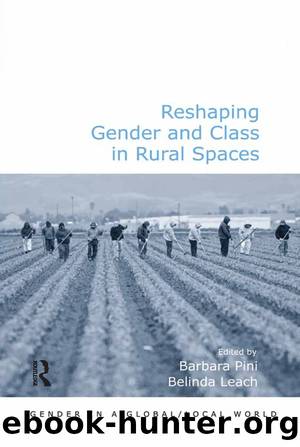Reshaping Gender and Class in Rural Spaces by Belinda Leach Barbara Pini

Author:Belinda Leach, Barbara Pini [Belinda Leach, Barbara Pini]
Language: eng
Format: epub
ISBN: 9781409489405
Barnesnoble:
Publisher: Ashgate Publishing Ltd
Published: 2013-03-28T00:00:00+00:00
Conclusion
In reporting on data from a study of the Ravensthorpe Shire in Western Australia this chapter has ulitized contemporary cultural class theory to investigate class relations and rurality. Moreover, it has brought a gender lens to the analyses exploring how community members negotiate the intersecting discourses, practices, and assumptions about femininity and masculinity, rurality and class.
Three different classed categories were examined in the chapter. The first, the classed differences between women involved with BHP Billiton either through their husbandâs employment or their own. In stark contrast to past scholarship which has reported on the critical importance of collective notions of class in resource affected communities (e.g., Williams 1981, Gibson-Graham 1991, 1994, 1996) participants in this study minimized or dismissed the place of class in their lives. This is no doubt indicative of the broader âdisidentification of classâ which has been found to be prominent today (Skeggs 2004: 59), a desire to establish oneself as âordinaryâ and âoutside classâ (Savage, Bagnall and Longhurst 2001: 875) as well as representative of the declining influence and power of unions in what is now largely a deregulated sector (Ellem 2004). While collective understandings of class may have diminished in mining, class is not necessarily irrelevant amongst the women who have an association with BHP Billiton. For example, it was clear that class informed social and leisure groups outside the workplace and was often signalled when introductions were made between women.
The second classed categorization examined in the chapter was between the âBHP Billiton womenâ and âthe contractorsâ while the third was between âmining womenâ and âfarming womenâ. The analysis of interviews demonstrated that the BHP Billiton women positioned contractors as responsible for a range of antisocial behaviour. Viewed as central to the contractorâs moral degeneracy was the fact that they were just in the community to obtain an income; an assertion that was also made by the farming women when talking about the mining women. In making such assertions interviewees dismissed the economic capital of these groups and drew attention to what they were seen to lack in terms of cultural, social and symbolic capital. The different groups engaged in âmoral boundary drawingâ (Sayer 2005: 952) delineating particular people, practices and attitudes negatively and others positively and, importantly, marking some as belonging in the rural and others as not belonging in the rural. This attribution of value, was, as this chapter has demonstrated, intrinsically gendered. It was, for example, not only that the women associated with mining were deemed by their agricultural counterparts as failing in their performance of normative middle-class rurality, but as failing in their performance of normative middle-class rural femininity. Integral to such a performance is an emphasis on home and family along with community and volunteer work.
Ravensthorpe provides a particularly rich case study for examining gender and class in the rural as it is a township which continues to undergo significant change. At the time of our interviews the classed and gendered conventions of this rural area were being opened up
Download
This site does not store any files on its server. We only index and link to content provided by other sites. Please contact the content providers to delete copyright contents if any and email us, we'll remove relevant links or contents immediately.
Chaco's Northern Prodigies : Salmon, Aztec, and the Ascendancy of the Middle San Juan Region after AD 1100 by Paul F. Reed(347)
Law Enforcement Interpersonal Communication and Conflict Management by Brian Douglas Fitch(342)
Digital International Relations by Unknown(336)
Critical Perspectives on Human Security : Rethinking Emancipation and Power in International Relations by David Chandler; Nik Hynek(322)
Skilled interpersonal communication: Research, theory and practice, Fifth edition by Owen Hargie(318)
The Enduring Color Line in U.S. Athletics by Krystal Beamon Chris M. Messer(317)
Evidence-Based Policy Making in Labor Economics by Hamermesh Daniel S.;Nottmeyer Olga K.;Nottmeyer Olga;King Sarah;King Sarah;King Sarah;(290)
EPSO CAST Political affairs EU policies: How to succeed in the selection procedure by Franco Reverte José María(281)
Criminological Theory in Context by John Martyn Chamberlain(264)
Writing Public Policy - A Practical Guide to Communicating in the Policy Making Process by Catherine F. Smith(263)
Threshold Concepts in Women's and Gender Studies by Christie Launius Holly Hassel(259)
Tibeton Yoga Its Secret Doc by Evans-Wentz(255)
Positive Psychology and Spirituality in Counselling and Psychotherapy (Conflict, Ethics, and Spirituality, 12) by unknow(254)
Social Problems, Social Issues, Social Science by James Wright(253)
Rothschild and Early Jewish Colonization in Palestine (Geographical Perspectives on the Human Past) by Ran Aaronsohn(253)
Play in child development and psychotherapy: toward empirically supported practice by Sandra W. Russ(247)
Cognitive Development in Infancy and Childhood (Elements in Child Development) by Mary Gauvain(245)
Latin American Politics and Society by Gerardo L. Munck & Juan Pablo Luna(216)
What Makes a Social Crisis?: The Societalization of Social Problems by Jeffrey C. Alexander(215)
